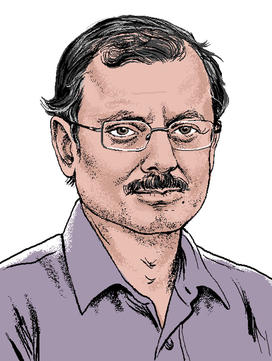Advancing a Smarter and Safer Internet of Things
Behind the Research: Niraj Jha, electrical engineering

For the past three years, Indian-born Princeton professor Niraj Jha has worked to advance machine learning by improving the software it runs on, known as artificial neural networks. Like a human brain, these networks take in information and create pathways to process it. But until now, the networks have been too cumbersome for small devices.
“If I have a smartphone, smartwatch, or even just a sensor, it is difficult to put neural networks on them because neural networks consume a lot of energy” and would quickly drain the device’s battery, explains Jha.
By adding useful connections and pruning away redundancies, just as a human brain does from babyhood to adulthood, Jha and his team have succeeded in making neural networks that are 10 to 1,000 times smaller than existing models — bringing the power of artificial intelligence into our pockets with the aim of revolutionizing health care, cybersecurity, and other fields.
Jha’s Studies: A Sampling
Illustrations: Mikel Casal
SHRINKING THE POOLBecause of the small amount of incoming data, devices for individual use, such as a smartwatch, may not have a large-enough sample size for AI to work effectively. But Jha and his team have developed a new algorithm, SCANN, that helps train the networks to process small- and medium-sized amounts of data, making AI feasible for personal tech. “You can find applications in many different domains. Health care is one. Cybersecurity is another. It could be aviation. It could be autonomous vehicles. It could be any of these internet-of-things [devices],” Jha says.
DIGITAL DIAGNOSIS
“Right now, health care is reactive: I fall ill, I go to a doctor, I hopefully get cured. We’d like to make it proactive,” Jha says. He and his team have created a neural network that analyzes data from smartwatches and smartphones to diagnose the onset of several diseases, such as diabetes, before the patient has even experienced symptoms. “In theory, we could be monitoring hundreds of diseases in parallel” and catching them early, when they are easier — and less expensive — to treat, Jha says. He and his team are working to incorporate mental-health diagnoses into the technology.
SMART SECURITY
Where there is more technology, there are more opportunities for malicious attacks. If an autonomous vehicle is hacked, for example, it can be made to crash. If an insulin pump is hijacked, it could release too much of the hormone and harm its diabetic host. So Jha and his team work to embed cybersecurity defenses into new “smart” tools while also providing protection for older products. For example, a 10- or 15-year-old pacemaker might not have the latest wireless encryption features, so Jha’s team developed MedMon, a pocket-sized monitor that works with pacemakers and other medical devices to intercept malicious signals.














No responses yet